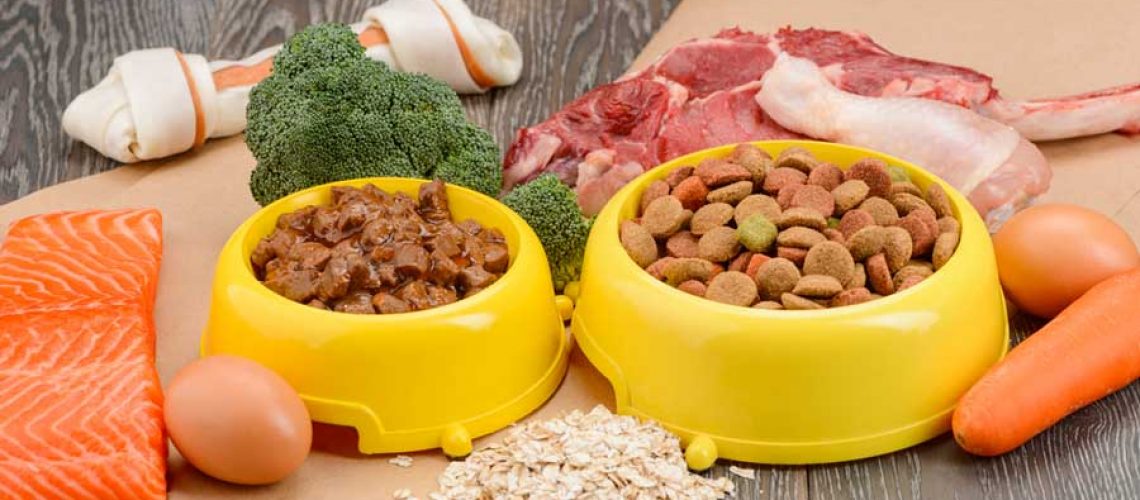Blog Post
Dry Vs Wet Dog Food — Which is Better For Puppies?

TLike regular parents, pet parents, too, want what’s best for their fur babies and give them the best puppy food. Once the weaning stage stops and your puppy has come off its mother’s milk, it’s time to start feeding the little tyke yourself. Unfortunately, just as deciding between breastfeeding and formula can be a hassle, it’s not clear most of the time what’s the best puppy food to give your puppy. First-time puppy parents, in particular, may struggle with transitioning their puppies’ diets from mother’s milk to solid food. Particularly, other than the question of how much to feed a puppy, it may not be easy to decide between dry and wet puppy food. Worry not; that’s why we’re here. Stick with us to find out everything you need to know about dry versus wet puppy food and which one is the best for your canine companion.
Three Types of Dog Food For Puppies.
While dog parents often get hung up on the choice between dry and wet dog food, there is, in fact, a third type of dog food as well: semi-moist. Clearly, the distinction has something to do with the water or moisture content present in the food.
The description of the four types of dog food for puppies is implicit in their names, but here’s a rundown for more clarity:
Dry dog food, also called kibble, has a moisture content ranging from 10%-12%. Dry dog food is hard, with a texture resembling biscuits. It comes in waxed paper bags, plastic bags, and less commonly in cardboard boxes. Examples of the best dry puppy food include the Nutrisource puppy food for small and medium breeds and the Diamond puppy food formula.
Wet dog food has a moisture content between 75%-78%. It typically comes in a can, which is why people also refer to it as “canned dog/puppy food.” It has a saucy texture, with meat and vegetable ingredients brining in a gravy. Examples of the best wet puppy food include the Blue Buffalo puppy food “Homestyle Recipe” and Royal Canin canned puppy food.
Semi-moist dog food is halfway between dry and wet food in terms of moisture content— roughly 60%-65%. It usually looks like wet dog food, only drier. A common variety resembles cannelloni pasta, minus the hollowness.
Additionally, dehydrated dog food also exists with a water content between 6%-9%. However, it is mainly meant for consumption by adult dogs.
The Problem With Semi-Moist Dog Food
While semi-moist products are readily available in the market, wet and dry dog food still hold sway in the dog community, among both experts and dog parents. In fact, semi-moist dog food gets quite a bad rap.
Semi-moist dog food typically contains more sugar and sodium than its counterparts. This can be good when you’re trying to get your dog to gain weight, so long as you offset the high sodium content with plenty of water. However, it’s not well-suited for dogs at risk of high blood sugar, high blood pressure, and coronary diseases.
Moreover, semi-moist dog food is usually brimming with artificial color, chemical preservatives, and flavor enhancers. Granted, wet and dry dog food also contains these chemicals, but in moderate quantities. Hence, you should use semi-moist dog food for puppies as an occasional treat.
The Big Difference Between Dry and Wet Puppy Food
The most obvious difference, of course, is their respective moisture content. The varying moisture content results from varying manufacturing processes, as detailed below:
Wet puppy food— the manufacturing process begins with grinding the proteins, be it beef or chicken, and meat by-products. This ground-up meat is then mixed with a gravy of grains (wheat, rye, barley, oats, maize, rice, etc.), minerals, and vitamins. Once processed, the gravy mix is cooked, sterilized, and canned for the shelves.
Dry puppy food— the manufacturing process begins the same way as wet puppy food. However, instead of gravy, the ground-up meat is combined with a bit of water to help form a dough. This dough is then shaped, heated, and sprayed with essential vitamins, oils, minerals, preservatives, and sometimes even probiotics to produce kibble.
The Big Difference Between Dry and Wet Puppy Food
Unsurprisingly, puppies have vastly different nutritional requirements than adult dogs. This is because puppies grow at an exponential rate, and they need a lot of essential nutrients to help them develop properly.
This is why puppy food generally has a higher calorie content than adult dog food, owing to greater quantities of fat (8% vs. 5%) and proteins (22% vs. 18%). Furthermore, the best puppy food contains higher amounts of sodium, calcium, and amino acids. Refer to this nutrient requirement chart by PetMD for further details.
But you don’t have to break your back looking for the right ingredients since the best puppy food usually contains a healthy balance of all nutrients in compliance with the Association of American Feed Control Officials. All you have to do is look for an AAFCO-approved label on the packaging.
How Much to Feed a Puppy
The general feeding requirements for puppies are as follows:
| Age.......... | Frequency of Feeding |
| 2-3 months........ | 4-6 meals a day |
| 3 to 6 months........ | 3 meals a day |
| 6-12 months...... | 2 meals a day |
The Pros and Cons of Wet Puppy Food
Pros
More flavorful— wet puppy food seems to be more palatable to dogs. The high flavor profile can be useful for encouraging puppies to come off of their mother’s milk and eat other foods.
Minimum chemicals— the reason why wet puppy food looks like colorless, unappetizing sludge is because it has no food coloring or chemical preservatives.
More moisture content— the high water content helps hydrate puppies who might otherwise not drink as much water. Remember that puppies aren’t used to gulping big sips of water since they rely on mama dog’s milk for hydration. The high moisture content is also suitable for puppies with urinary or kidney diseases.
Richer in proteins and fats— while dry dog food is rich in carbs, the best puppy food is loaded with proteins and fats, which are more essential macronutrients for growing puppies.
Easier to chew— Wet puppy food is soft and chewy, which is perfect for teething puppies. Satiety— dogs appear to be more “full” after eating small amounts of wet food compared to larger amounts of dry food. This will help the hungry little tykes hold out until their next meal. C
ons
More expensive— wet puppy food is the most expensive type of dog food and will hurt your pocket. Quick-spoiling— once you open that can, wet puppy food starts to spoil pretty quickly. You’ll have to store leftovers in the fridge or throw them away within the hour. The Pros and Cons of Dry Puppy Food So far, wet puppy food seems to be taking the lead. But dry dog food brings its own benefits to the table. Pros Affordable— Dry puppy food is generally less expensive per calorie than wet food. Dental hygiene— some research suggests that dry dog food prevents dental issues such as the buildup of tar. Easy to store— Dry dog food doesn’t spoil thanks to preservatives, and so it is easier to keep in the pantry. Since it doesn’t spoil, you can even reuse the leftovers instead of having to throw them away. Contains probiotics— certain types of dog food contain probiotic supplements to help with digestion, which is great considering how underdeveloped puppies’ digestive systems are. Food enrichment— kibble is the go-to snack to use for food puzzles to provide your puppy with mental stimulation. Cons Not as palatable— puppies may not enjoy dry puppy food because it lacks the punch of flavor that wet food packs. High chemical content— dry food has high concentrations of both preservatives and food coloring. Difficult to chew— even some adult dogs can have a difficult time chewing dry dog food, so you can imagine how tough it must be for puppies with their tiny teeth. You might have to grind up the kibble before feeding it to your pup.
Dry Vs Wet Puppy Food- The Verdict
Here’s the answer to the million-dollar question, “what is the best puppy food—dry or wet?”
Generally speaking, both dry and wet dog food fare well enough for all dogs. After all, the quality of the food is more important than the moisture content in it.
However, when it comes to puppies, you might be better off using wet puppy food instead. It’s softer and therefore easier to chew, has more water which is important for young pups, and dogs can’t seem to get enough of the flavor of wet dog food.
You can then start incorporating dry puppy food into your puppy’s diet to get them used to different textures and flavors of food. This way, you won’t raise a picky eater.


Comments
Maria Silva USA♥
Cras sit amet nibh libero, in gravida nulla. Nulla vel metus scelerisque ante sollicitudin commodo. Cras purus odio, vestibulum in vulputate at, tempus viverra turpis. Fusce condimentum nunc ac nisi vulputate fringilla. Donec lacinia congue felis in faucibus.
ReplyMariane Lindberg USA♥
Cras sit amet nibh libero, in gravida nulla. Nulla vel metus scelerisque ante sollicitudin commodo. Cras purus odio, vestibulum in vulputate at, tempus viverra turpis. Fusce condimentum nunc ac nisi vulputate fringilla. Donec lacinia congue felis in faucibus.
ReplyNested Comment USA♥
Cras sit amet nibh libero, in gravida nulla. Nulla vel metus scelerisque ante sollicitudin commodo. Cras purus odio, vestibulum in vulputate at, tempus viverra turpis. Fusce condimentum nunc ac nisi vulputate fringilla. Donec lacinia congue felis in faucibus.
Reply